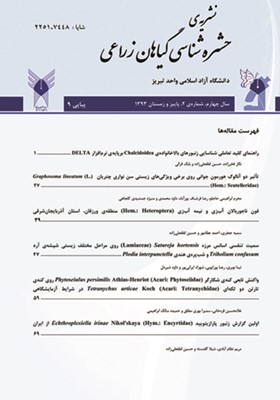اثر چند حشرهکش در تلفات برخی دشمنان طبیعی مزارع ذرت دشت مغان
محورهای موضوعی : حشره شناسی گیاهان زراعی
کلید واژه: کنترل شیمیایی, دشمنان طبیعی, کرم ساقهخوار اروپایی ذرت, Ostrinia nubilalis, حشرهکشهای بیولژیک,
چکیده مقاله :
اثر کشندگی حشره کش های پیریدالیل، اسپینوساد، ایندوکساکارب، دلتامترین، تیودیکارب، کلرپایریفوس، Bt خارجی (بل تیرول) و Bt داخلی (بیتورین) روی تعدادی از دشمنان طبیعی کرم ساقه خوار اروپایی ذرت (Ostrinia nubilalisHubner) از جمله Stethorus spp.، (Stephens)Chrysoperla carnea، Habrobracon hebetor (Say) و Orius spp. مقایسه شد. آزمایشها در قالب طرح بلوک های کامل تصادفی با سه تکرار در طول فصل زراعی سال90 در مزارع ذرت دشت مغان انجام گردید. قبل از تیمار و هفت روز پس از آن، تعداد حشرات مفید شمارش گردید. بیشترین درصد تلفات کفشدوزک Stethorus spp. مربوط به تیمار تیودیکارب در نسل اول و کلرپایریفوس در نسل دوم و کمترین درصد تلفات آن مربوط به Btداخلی در نسل اول و دوم بود. بیشترین درصد تلفات C. carnea در نسل اول مربوط به تیمار دلتامترین و در نسل دوم در تیمار تیودیکارب و کمترین درصد تلفات در نسل اول مربوط بهBt خارجی و در نسل دوم مربوط به Bt داخلی بود. هم چنین بیشترین درصد تلفات H. hebetor مربوط به تیمار کلرپایریفوس در نسل اول و دوم و کمترین میزان آن مربوط به Bt خارجی در نسل اول و دوم بود. بیشترین درصد تلفات Orius spp. نیز مربوط به دلتامترین در نسل اول و کلرپایریفوس در نسل دوم و کمترین میزان آن مربوط به Bt داخلی در نسل اول و Bt خارجی و Bt داخلی در نسل دوم بود.
Lethal effects of insecticides: pyridalyl, spinosad, indoxacarb, deltamethrin, thiodicarb, Bt (Bitorin), Bt (Belthirul) and chlorpyrifos were evaluated on a number of natural enemies of European corn borer (Ostrinia nubilalis Hubner): Chrysoperla carnea (Stephens), Habrobracon hebetor (Say), Stethorus spp. and Orius spp. The experiment was performed in a Randomized Complete Block Design with 9 treatments and 3 replications in Moghan in 2011. Samplings were done 1 day before and 7 days after treatments via counting the number of alive natural enemies. The means of mortality percentages were compared through Duncan Multiple Range test. The data analyses were done using SAS 9.1. Maximum mortality of Stethorus spp. was observed in thiodicarb during 1st generation of pest and chlorpyrifos during 2nd generation. The least mortality was observed in Iranian Bt. The mortality of C. carnea was the highest in deltamethrin and thiodicarb in 1st and 2nd generations, respectively, while the mortality was the lowest in Bt (Belthirul)and Bt (Bitorin)in 1st and 2nd generations, respectively. The mortality of H. hebetor was maximum in chlorpyrifos in two generations, while it was minimum in Bt (Belthirul) treatment. The maximum mortality of Orius spp. was in deltamethrin and chlorpyrifos during 1st and 2nd generations, respectively. The minimum mortality of Orius spp. was observed in Bt (Bitorin) and Bts in 1st and 2nd generations, respectively.
Baker WA, Bradley WG, Clark CA. 1949. Biological control of the European corn borer in the United States. USDA Technical Bulletin 983: 1-185.
Behdad E. 1989. Pests of Field Crops in Iran. 2nd Edition, Neshat Pub., Isfahan, 618 pp.
Bigler F, Brunetti R. 1986. Biological control of Ostrinia nubilalis Hbn. by Trichogramma maidis Pint. et Voeg. on corn for seed production in southern Switzerland. Journal of Applied Entomology 102: 303-308.
Capinera JL. 2001. Handbook of Vegetable Pests. Academic Press, San Diego. 729 pp.
Chapman AV, Kuhar TP, Schultz PB, Leslie TW, Fleischer SJ, Dively GP, Whalen J. 2009. Integrating chemical and biological control of European corn borer in Bell pepper. Journal of Economic Entomology 102: 287-295.
Coll M, Bottrell DG. 1992. Mortality of European corn borer larvae by natural enemies in different corn microhabitats. Biological Control 2: 95-103.
Elzen GW, Elzen PJ, King G, Dugger P, Richter D. 1998. Laboratory toxicity of insecticide residues to Orius insidiosus, Geocoris punctipes, Hippodamia convergens, and Chrysoperla carnea. Proceedings Beltwide Cotton Conferences, Volume 2, 5-9 January 1998, San Diego, California, USA. Pp. 1235-1238.
Godfrey LD, Godfrey KE, Hunt TE, Spomer SM. 1991. Natural enemies of European corn borer Ostrinia nubilalis (Hübner) (Lepidoptera: Pyralidae) larvae in irrigated and drought-stressed corn. Journal of the Kansas Entomological Society64: 279-286.
Henderson CF, Tilton EW. 1955.Tests with acaricides against the brown wheat mite. Journal of Economic Entomology 48: 157-161.
Khanjani M. 2004. Crop Pests in Iran. Bu-Ali Sina University Pub., 731 pp.
Lewis LC, Gunnarson RD, Robbins JC. 2005. Trichogramma brassicae, an integrated approach to managing European corn borer and corn rootworms. Biocontrol 50: 729-737.
Naeem A. 1979. Corn. Plant Protection Institute Pub., Neshat Print., Isfahan, 235 pp.
Najafi-Navai IA, Taghizadeh M, Javan-Moghaddam H, Oskoo T, Attaran MR. 2002. Efficiency of wasps Trichogramma pintoi and Habrobracon hebetor against Ostrinia nubilalis and Helicoverpa sp. on maize in Moghan. 15th Iranian Plant Protection Congress, 7-11 September 2002, RaziUniversity of Kermanshah, 193-194 pp.
Romeis J, Meissle M, Bigler F. 2006. Transgenic crops expressing Bacillus thuringiensis toxins and biological control. Nature Biotechnology 24: 63–71.
Romeis J, van Driesche RG, Barratt BIP, Bigler F. 2008. Insect-resistant, transgenic crops and biological control. In: Romeis J, Shelton AM, Kennedy GG. (eds.) Integration of Insect-Resistant Genetically Modified Crops within IPM Programs. Springer Science + Business Media BV, Dordrecht, the Netherlands, pp. 87–117.
Steinhaus EA. 1959. On the improbability of B.t. Formes Pathegenic Engenering Entomology 52: 506-508.
Straub RW, Emmett B. 1992. Pest of monocotyledon crops. In: McKinley RG. (ed.), Vegetable Crop Pests. The MacMillan Press Ltd., pp 213-262.
Tally S, Bledsoe L, Martin M. 1997. Purdue News. http:www.purdue.edu.UNS.html4ever.9610. Bledsoe.BtCorn.html [Accessed on 12 March 2012].
Thompson G, Hutchins S. 1999. Spinosad. Pesticide Outlook 10(2): 78-81.

